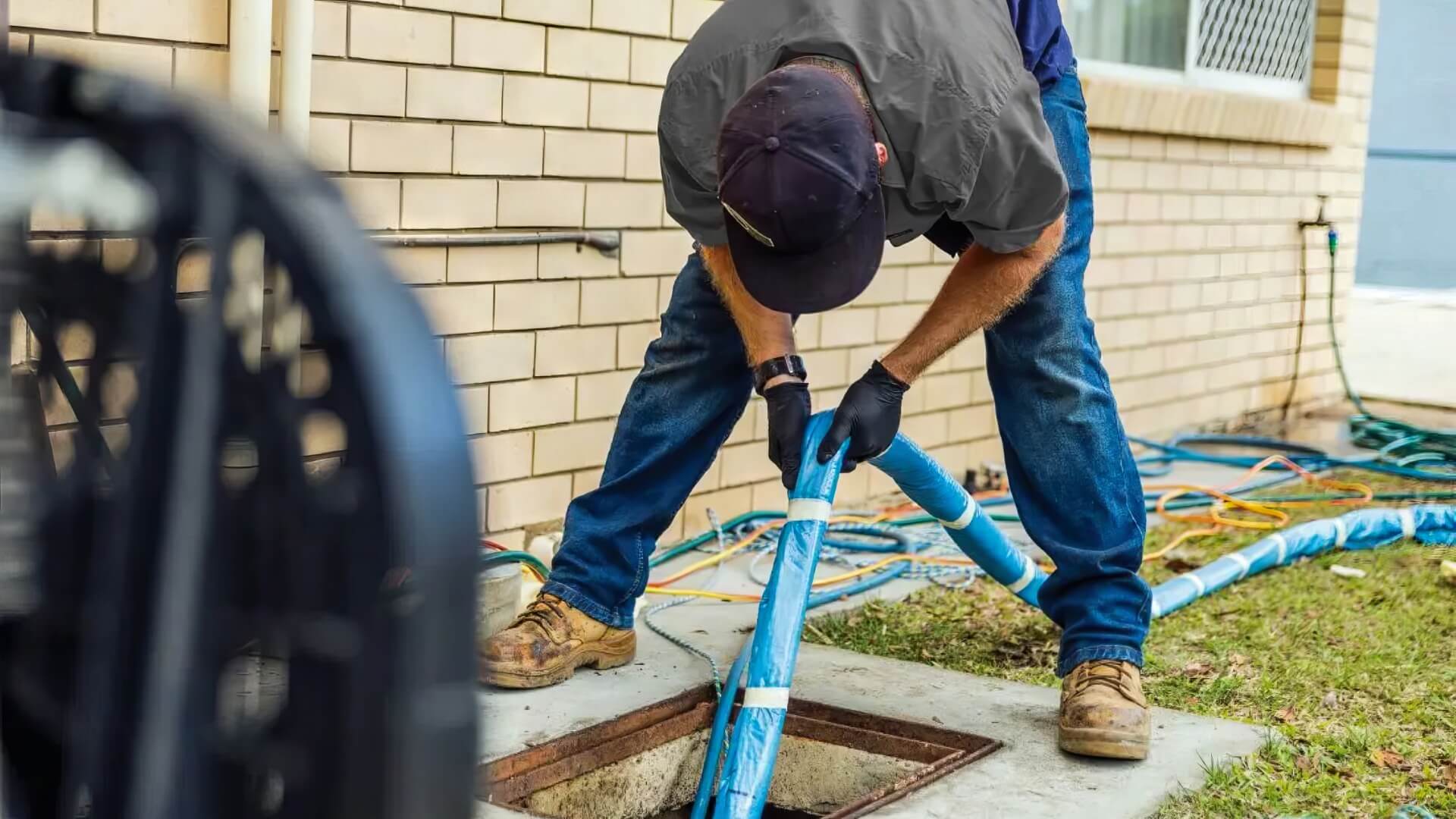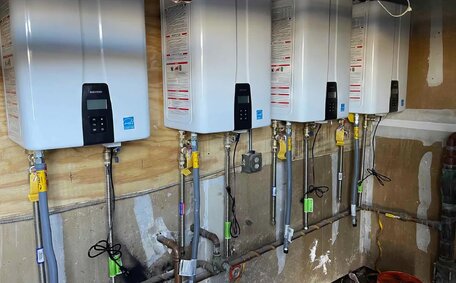Introduction to Hot Water System Leaks
Hot water is essential in Australian homes, and even dependable systems may develop leaks due to wear or faulty components. Identifying and fixing water leaking in a hot water system promptly is crucial to prevent inconvenience, property damage, and risks from burst pipes or flooding.
Colyton Plumbing is here to instruct homeowners on detecting, diagnosing, and mending common leaks in hot water systems. We’ll guide you through potential causes, DIY repairs, and situations that warrant professional intervention to ensure your repairs are safe and up to code.
As an established plumbing business serving Colyton and wider Sydney for over 10 years, Colyton Plumbing has the expertise and experience to assist with all your hot water system issues. If you’re wary of a potential leak or require any plumbing service, don’t hesitate to call us.
Identifying the Source of the Leak
Start identifying a leak in your water heater by visually inspecting around the water meter and nearby areas.
Watch for water on the floor or pipeline drips that signal an active leak. Additionally, inspect the pipes fittings, valves, and joints for mineral build-up or corrosion, which heightens your suspicions for potential water coming through via previous leaks.
Listen for noises such as running water or drips that could point to a leak, making sure to do so when the tank is silent. The sound may pinpoint where leak in your hot water tank is occurring, be it internal tank corrosion or plumbing connections. Running a hand around the underside of the tank and along visible pipes to feel for moisture can help detect and fix the problem of a hot water leak.
Leaks often emerge at the connections of cold water intake pipes; a tell-tale sign is the presence of worn washers. Gas water heater leaks often arise at joins and valves from expansion and corrosion. Damage around safety valves can cause hot water heater discharge as pressure builds and potentially lead to consistent leaking issues.
If you pinpoint the leak, follow our troubleshooting steps; if not, contact a professional plumber for thorough detection and repair.
Checking Pressure Relief Valves
A hot water system can feature pressure relief valves as important safety devices. They help protect the tank from building up dangerous internal pressure by allowing water to be discharged if the pressure passes the valve’s preset limit.
The most common pressure relief valve is the temperature pressure relief valve (TPRV). The TPRV activates to release water automatically when the tank’s temperature or pressure exceeds safe levels. Common triggers for leaks in the components above water heater, such as the TPRV, include:
- Faulty valve due to old age, build up of scale, or corrosion
- Excessive water pressure entering the hot water system
- Thermostat failure causing continuous heating past boiling point
A minor leak from the TP valve often indicates deeper issues, requiring a licensed professional’s inspection to prevent major faults. Have a licensed plumber inspect the valve and water heater to rectify over-pressurisation and replace old valves.
Ensure you switch off power and turn off water supply before conducting any DIY checks or repair attempts on the TPR valve. Contact Colyton Plumbing if you need assistance.
Inspecting Pipes and Fittings
Carefully examining the pipe fittings and plumbing is essential to spot minor leaks and effectively assess your hot water system. Carefully check inlet and outlet pipes leading to and from the tank for dampness, mineral deposits, or corrosion which can indicate small leaks.
Additionally, check for loose connections by gently wiggling the pipes; if there’s movement, turn off the main water supply before proceeding. If there’s no tightness, they will need adjustment and securing to determine if that ceases leaks. When tightening fittings:
- Switch off electricity and shut off water supply to the system
- Protect connections with a cloth when adjusting fittings
- Tighten by hand initially before using any tools sparingly
- Turn water and power back on slowly to check for leaks
Be wary of over-tightening fittings to prevent damages to pipes or valves, and always cut off water supply prior to adjustment. Contact Colyton Plumbing if you have any trouble inspecting or securing pipe join
Locating External Leaks
Your own external plumbing lines may be the source of a leak connected to the hot water system, rather than it originating from the tank itself, affecting your water usage. Check the main inlet pipe and the hot water outlet pipe for any signs of water system leaking, and find out more about the potential sources.
Search for damp or rusty spots on external surfaces, which could indicate a pinhole leak. Corrosion from contacts with surrounding materials or damage from movement can cause small leaks to develop over time.
Also inspect the bottom of the tank leaking and anywhere the pipes meet the wall or floor for signs of water marking. If space allows, run your hand around pipes to feel for moisture. Catching external leaks early prevents more significant leaks inside walls and ceilings.
If an external leak is suspected but hard to locate, your local professional leak detection service using specialised tools can pinpoint the issue. Contact Colyton Plumbing for assistance with your electric solar water heater leaks amongst other types.
Common Causes of Hot Water System Leaks
Age and Wear
As hot water systems age, internal components and fittings are subject to deterioration over time. From top to the bottom of your system can experience corrosion, loosening of parts, and cracking or splits in the tank which cause water to leak out. Hot water systems typically endure 8-12 years before replacement is necessary; they may no longer function correctly if not properly maintained.
High Water Pressure
Consistently high water pressure your water system encounters can exert strain on valves and seals. This can accelerate wear and cause parts to fail or leaks to form. Checking your water mains pressure and installing a pressure limiting valve if over 500 kPa can help prevent leaks from faulty pressure.
Sediment Buildup
In areas with hard water, the tank’s bottom is especially prone to accumulating mineral deposits and sediment. This abrasive sediment can damage the metal from the top bottom of the inside tank, causing pinhole leaks that expand with time. Annual flushing of sediment from the tank is recommended.
DIY Repairs for Minor Leaks
For small leaks that are easily accessible and not rapidly leaking, some basic DIY repair work can be undertaken before calling a professional.
If the leak comes from fittings or pipes, consider tightening joints as previously described.
Ensure water supply and power are off before investigating fittings. Replace aged washers on connections as these commonly fail over time. Ensure water supply and power are off before investigating fittings.
To manage minor drips from a pinhole hot water tank leaking, apply an emergency leak control putty or epoxy temporarily. Follow manufacturer instructions closely when using these products. This strategy avoids new water loss while anticipating tank replacement.
If you’re unsure about the repair method or if leaks persist, consult a licensed plumber and switch off your system. DIY repairs can do wonders when undertaken with caution for easily accessible minor leaks in the hot water system.
When to Call a Professional Plumber
While it’s useful to also check leaks that can often be repaired with basic DIY methods, there are important instances when a professional plumber is essential:
- If the leak originates from the hot water storage tank itself, it likely indicates corrosion, and you’ll need to learn how fix or replace the tank due to imminent failure. Attempting tank repairs is not advised.
- For rapid source leak causing flooding or water damage in your house. Swift professional help prevents more expensive repairs to your property and may need turn off immediate water sources.
- If water discharge occurs from the TPR valve due to excess pressure or overheating. Defects in the thermostat may cause hot water system malfunctions, necessitating an investigation.
- When the source of leakage cannot be located through household inspection and isolation methods.
- Should the leaks endure despite DIY attempts to mend pipe joins, fittings, and washer replacements, call professional help.
- To turn off gas hot water systems, ensuring repairs meet strict safety and compliance standards.
Colyton Plumbing are fully qualified and equipped to locate leak sources, repair or replace components, and restore full hot water functionality. Contact our friendly team for assistance with leaks, maintenance or replacements.
Replacing vs Repairing Your System
Replacement
It may become necessary to replace an older hot water system if it is more than 10 years old or critical components have substantial corrosion. Although an investment, installing a new hot water system will enhance energy efficiency, including benefits like instant hot water, and it will prove to be more dependable.
Repair
Professional plumbers can often repair minor leaks from fittings, valves, or pipes. However, if leaks in your hot water system originate from within the storage tank, it typically indicates irreparable internal corrosion requiring system replacement.
Take into account the system’s lifespan and expenses when choosing whether to mend or introduce a new hot water system. Seek professional advice from qualified plumbers like Colyton Plumbing to determine the best solution.
Preventing Future Leaks
Properly maintaining your hot water system is crucial to prevent unit damage. Some key maintenance tips include:
- Flush the water tank annually to remove sediment buildup. Allowing deposits to accumulate can lead to corrosion and cracks over time.
- Install a pressure limiting valve if mains pressure exceeds 500 kPa and make sure your system is turned off while doing so. This regulates flow to protect valves and fittings.
- Leaking valves and fittings can replaced immediately to avoid bigger problems. Use PTFE tape on threads for better seals.
- Consider replacing hot water heaters older than 10 years to improve efficiency and reliability.
- Have a plumber inspect the system every 2-3 years and replace corroded parts like anodes. This extends tank life.
Undertaking regular hot water system maintenance prevents leaks by monitoring components and addressing minor issues before they worsen. For professional servicing and repairs, contact the team at Colyton Plumbing on 1300 349 338.
Inspecting and Maintaining Your System
Consistent inspection and maintenance are critical to maximising your hot water system’s lifespan and preventing leaks or malfunctions. It is recommended to have a professional service every 2-3 years, however some basic maintenance checks you can perform yourself between services include:
- Check the water pressure entering your system annually using a pressure gauge. Pressures consistently exceeding 500 kPa can accelerate wear.
- Perform visual checks on all pipe connections to your water heater, looking for any hot water stains or corrosion signs biannually. Tighten fittings if loose. Replace rusted pipes.
- Flush hot water tanks annually by attaching a hose to the drain valve and allowing water to flow for 5 minutes. This removes sediment buildup reducing corrosion.
- Immediately substitute any leaking taps, ensuring the tap lever is secure, and Replace visible seals or damaged pipe sections to preempt further damage.
the above, by law all plumbing work must be carried out or inspected/approved by a licenced professional. Contact Colyton Plumbing on 1300 349 338 regarding:
- Upgrading pressure relief valves older than 5 years, particularly for electric water systems
- Replacing or servicing an anode rod in your hot water tank every 3-4 years as this prevents corrosion
- Testing and re-gassing solar hot water systems or electric models
Installing Water Pressure Regulators
Excessive water pressure frequently leads to leaks in your hot water system over time. Consistently high pressure above 500 kPa strains various components, such as valves and fittings, paving the way for failures. Installing a water pressure limiting valve is an effective way to prevent such high pressure damage.
To modulate this challenge, pressure limiting valves are installed on your main water supply line, prior to entering your home. They automatically reduce pressure down to safe levels between 350-500 kPa. This guards against an excessive amount water with high pressure that may prompt the need to turn off and potentially impact the hot water system and other plumbing.
Learn how Colyton Plumbing’s licensed experts can supply and install a regulator valve tailored to your home’s needs. This small investment helps avoid expensive repairs down the track caused by leaking valves, connections and tanks due to excess water pressure.
Schedule a water pressure test during your next hot water service; our technicians can then determine if a regulator is necessary and facilitate a seamless installation.






